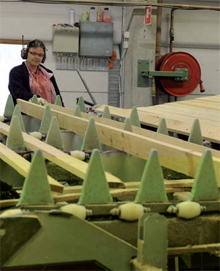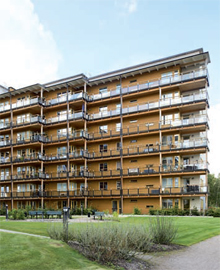Something old, something new
29 June 2013Swedish timber suppliers are exploring new markets, geographically and in terms of value-added products but, says Swedish Wood director Mikael Eliasson, they remain committed to the UK market.
The Swedish sawmilling industry is going through a very challenging period due to the continuing weak economies in the main markets in Europe and the strong Swedish krona. In addition, Swedish sawmills have to contend with high log prices reducing their margins.
Production declined during 2012 and the beginning of this year and is now under 16 million m³ per year. The reduction is particularly noticeable in the south where the aftermath of the big storms of 2005 and 2007 has reduced the annual cutting levels, causing an imbalance of raw material supply.
There have been some shutdowns and bankruptcies - although surprisingly few, given the economic climate. And, if we take into account the new big investments in south Sweden during the latter years, the total capacity has actually grown. However, this capacity is generally not fully utilised as many sawmills have reduced their working hours. In common with Europe's other main producing countries our market is now supply driven.
Despite the importance of the sawmilling industry and its contribution to the Swedish economy it doesn't enjoy any specific support or subsidies. On the contrary, there are political actions that will have a negative effect on our industry, such as the sulphur directive (limiting the maximum sulphur content in marine fuels) that will lead to higher costs for sea freight.
Due to the very tough business environment of recent years the focus has simply been to manoeuvre the industry through this period and, as a consequence, investments - particularly major ones - have declined.
Sawmills are focusedon keeping margins and results healthy by cutting costs, reducing working capital, intensive optimisation and exploring new market options. Parallel to this, however, the industry continues to invest in promotion, domestically as well as on prioritised export markets, and in ambitious R&D.
The domestic timber market has also been affected by the financial downturn, although the Swedish economy has been more robust than the rest of Europe. Building activity is at an historic low but is countered to some extent by RMI. However, the DIY and building season started later this year because of the long hard winter that stretched beyond the first quarter.
The percentage of value-added products is steadily increasing, especially of DIY/builders merchants and construction-related products in European markets.
Joinery sector customers are looking for more advanced products and components from timber suppliers in order to concentrate their efforts and investments further down the value chain.
Sweden is one of the leading countries when it comes to forest certification, with roughly twothirds of its forests covered by FSC and PEFC.
Wood is a renewable material from sustainably managed forests. It also acts as an efficient carbon sink and generally offers a climate-efficient alternative to other nonrenewable materials. Various life cycle analyses confirm these advantages and there are different initiatives going on in Sweden and at a European level that aim to bring forward these facts which are vital in order to back up our environmental claims.
Strengthened by the fact that our product is a renewable material with outstanding environmental performance, we do have a real future market potential in the building sector. We have new hungry markets outside Europe that have come to know our products and our capacity as a sustainable supplier. As a result, our industry has a strong belief in its future.
New markets
Swedish timber exporters have developed good business in the Middle East and North Africa and that has compensated for the downturn in the traditional European markets. In recent years new markets - Poland, Turkey and India - have also opened up. The dynamic Chinese market has also developed positively and is expected to increase its purchasing from Sweden this year. In addition, more volume is expected to be shipped to the US, where housebuilding shows signs of improvement.
However, the UK remains our most important export market. The 2012 statistics show that Swedish exporters account for 50% of the UK's total imports of sawn softwood. There are many reasons behind this. First of all Swedish producers can provide timber products for almost the UK market's every need. There are also well-established contacts, as well as efficient logistics and distribution systems.
The Swedish industry has taken a long-term view when it comes to developing the UK market and has played an active role in both generic as well as more specific promotion of timber and timber products for some time.
For example, the Swedish timber sector was the leading contributor to the Wood for Good campaign that started in 2000, and it is still a highly active partner to the UK-based industry.
There is a clear message to the UK market from the Swedish sawmilling industry - we are here to stay!


